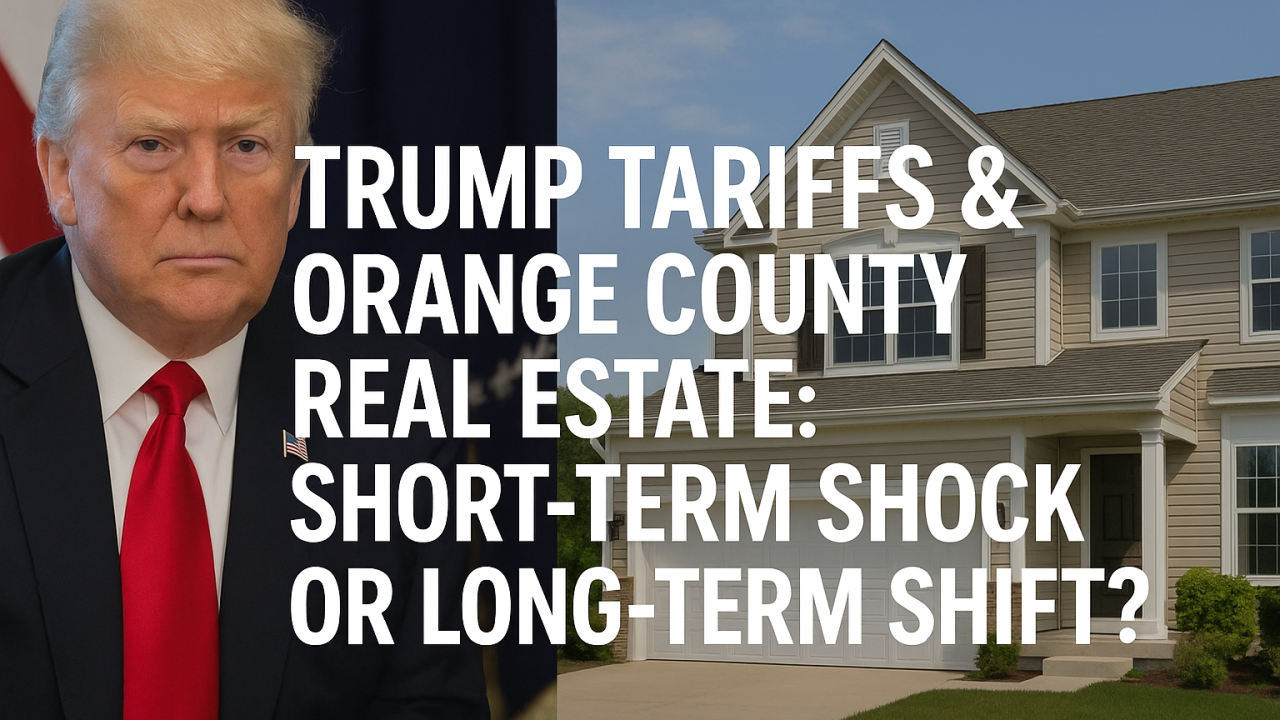June 18, 2025
In April 2025, sweeping U.S. tariffs were reintroduced under the Trump administration, marking the most significant escalation in trade policy since the Great Depression. The move has triggered new conversations across the financial and real estate sectors—including right here in Orange County, CA.
At the same time, the Federal Reserve held interest rates steady at 4.25–4.5% and raised its inflation forecast to 3%, citing the potential impact of tariff-related cost pressures.
This raises a timely question: Could these tariffs trigger short-term pain—or lay the groundwork for long-term opportunity in our local housing market?
Let’s examine both sides.
⚠️ Short-Term Headwinds: Inflation, Uncertainty & Rising Costs
The Fed’s cautious stance reflects concern that import tariffs may push businesses to pass costs to consumers. Recent surveys show inflation expectations climbing to 4.9% over the next year. In a high-cost housing market like Orange County—where the median home price sits near $1.4 million—this could have ripple effects.
Potential Impacts in the Near Term:
- Buyers: First-time buyers could face more affordability pressure as inflation and adjustable mortgage rates rise.
- Developers: Tariffs on construction inputs, such as steel (up to 50%), may drive up building costs, slowing the addition of new inventory.
- Investors: Stock market volatility tied to tariff policy has added uncertainty, potentially affecting real estate confidence and capital flow.
The result? Construction timelines may extend, new listings could slow, and affordability—especially at the entry level—may become more strained.
🔍 Long-Term Possibilities: Economic Reshaping Through Trade
While short-term effects dominate headlines, some economists and policy analysts suggest that tariffs could contribute to broader structural changes in the U.S. economy.
Here’s how those outcomes could play out for Southern California real estate if these shifts take hold:
🔧 Manufacturing Jobs Return – Potential Wage Growth
If the goal of reshoring production is successful, it may lead to higher-wage, skilled employment in adjacent regions, such as the Inland Empire or Los Angeles. That wage growth could improve affordability for mid-tier housing in cities like Anaheim, Fullerton, or Lake Forest, potentially stabilizing local demand.
🏗️ Domestic Production – Smoother Supply Chains & Local Sourcing
Reducing reliance on imported goods could eventually ease supply chain vulnerabilities and encourage the domestic manufacturing of materials.
This could:
- Help stabilize construction costs over time
- Encourage corporate relocation to logistics-friendly cities like Irvine or Costa Mesa
- Increase demand for both commercial and residential development tied to new industry
💰 Trade Deficit Reduction – Possibility of Lower Long-Term Rates
If tariffs help reduce foreign debt exposure by shrinking the trade deficit, this could lead to greater economic autonomy and, ultimately, more stable or lower interest rates.
That could benefit:
- Luxury and move-up buyers in markets like Newport Coast, Laguna Niguel, and Dana Point
- Investors looking for lower-cost financing over time
🧩 Orange County: Who Might Gain or Lose?
👨👩👧👦 Buyers
- Short-term: Affordability challenges persist due to elevated rates and inflation.
- Long-Term: If wages rise and inflation normalizes, more households could gain access to homeownership.
💼 Investors
- Short-Term: Volatility may temper risk appetite.
- Long-Term: New development hubs and wage growth could enhance property values and rental yields in select areas.
🏡 Homeowners
- Many will remain insulated from volatility, especially those with fixed-rate mortgages.
- If the broader economy strengthens, home appreciation could continue across Orange County’s established neighborhoods.
🧠 What the Fed’s Messaging Tells Us
Fed Chair Jerome Powell has voiced concern that the inflationary effects of tariffs—while not fully realized yet—could become a “sustained problem” if expectations shift. At the same time, the Fed is also signaling that slower growth may be a more pressing risk, especially if consumer spending or hiring slows further.
Here in Orange County, higher-income households may continue to buy, but entry-level buyers could be squeezed, widening the region’s affordability gap.
🧭 Final Thought: Navigating an Uncertain but Defining Moment
Like many economic policies, tariffs entail both risks and potential benefits. They may:
- Increase pressure on prices and borrowing in the short term
- Encourage long-term job creation and industrial investment
- Reshape regional economies in ways that could either uplift or disrupt housing markets
The future impact on Orange County real estate will depend on how effectively these policies are implemented—and whether inflation, interest rates, and supply chain issues stabilize.
What’s your take? Are these policies setting the stage for economic strength, or creating more obstacles than solutions? I'm curious to hear from others tracking the housing market closely.
Let’s continue the conversation.
🏡 Explore More: 🔗 Orange County Housing Report 🔗 Los Angeles Housing Report 🔗 My Zillow Profile 🔗 Get an Instant Home Value 🔗 Request a Cash Offer 🔗 Listing Showcase Strategy
